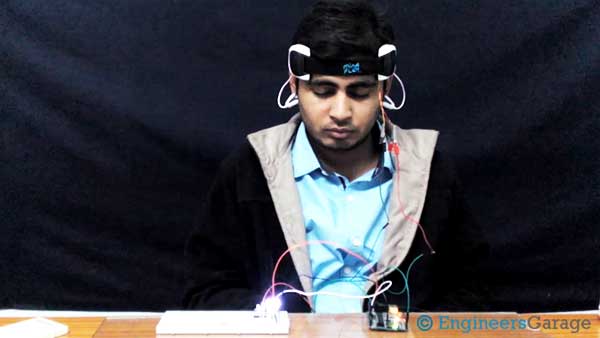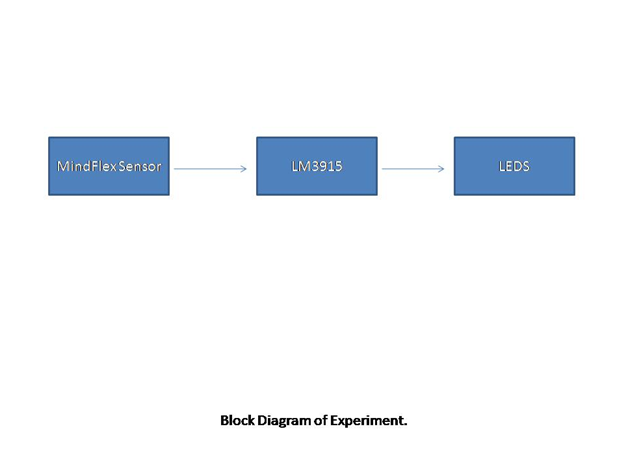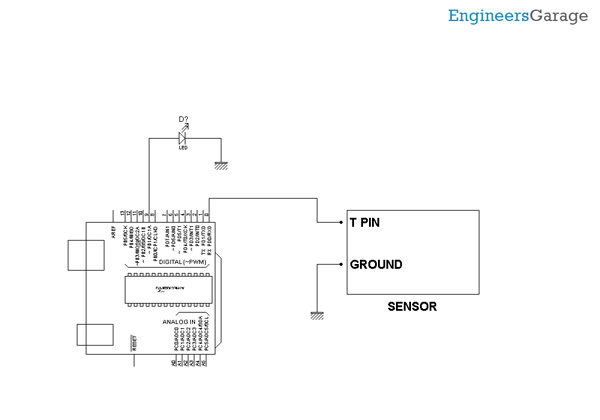How to detect Variation in EEG Signals in the form of LEDs using LM3915
SUMMARY
After taking on the experiment of appliance control with relay, I am thinking of analyzing the EEG wave produced by the brain and see the variations in the form of LEDs. It would be really nice if we could see the variations of our EEG signals clearly in the form of some LED patterns so as to analyse how much variation it is producing by various thinking processes. Let’s get started.

Fig. 1: Image showing EEG Signals Displayed as LEd Light Variation
DESCRIPTION
I decided to use LM3915 IC which can convert the analog voltage into the digitized form from 1 to 10 and turn as many number of LEDs as the digitized value. It can also be termed as ADC (Analog to Digital Convertor). By analyzing our wave on CR, we have seen that the voltage range is upto 1V. So, we set the reference of the LM3915 to 1V. By doing this we convey to the LM3915 that 0v means 0 LEDs and 1V means 10 LEDS. So now let’s say 4 LEDs are glowing, this means that the voltage is near to 0.4 V. We have just sent the analog EEG signal directly to the LM3915 IC and attached LEDs at the other end for the result. Please watch the video for the experiment.

Fig. 2; Image showing EEG Signals displayed as LEd Light Variation
We can conclude that the waves are not very stable in magnitude. I also believe that there will be some noise which has been transferred to the 3915 IC. This can also be seen that many times the LEDs go to full magnitude and remain there, which is not the case when checked with CRO. This can be due to the noise as we have just soldered the wire and it is open and long too. Anyways, Brain waves are very interesting and I am still searching to find some patterns in them to perform more such experiments. By this experiment, I have found the variation in our EEG and the effect of noise. I am assuming this as a noise but it can be something else.

Fig. 3: Block Diagram of MindFlex Brainwave Sensor based EEG Signal LED Indicator
Hardware: Please find the attached circuit diagram of the connections that are to be established. We have soldered a pin from the EEG pin of the Mindflex sensor and inserted the output of the EEG pin to that of input of the LM3915. Moreover, we have also set the reference voltage to 1V as our EEG signals will not cross this value. For setting 1V, we are using the resistor network. Though we can use 10 LEDs with the 3915IC but here we will only use 4 LEDs just to see the variations and change of our EEG wave.
Softwares: There is no coding done in this experiment.
Few points to Note:
Try to shield this wire and also make sure that the references probes are correctly connected. You can try this experiment and share your feedback with us. In the next experiment we will try to change the color of the RGB LED.
Project Source Code
###
//Program to/*FadingThis example shows how to fade an LED using the analogWrite() function.The circuit:* LED attached from digital pin 9 to ground.Created 1 Nov 2008By David A. Mellismodified 30 Aug 2011By Tom Igoehttp://arduino.cc/en/Tutorial/FadingThis example code is in the public domain.*/int ledPin = 9; // LED connected to digital pin 9void setup() {// nothing happens in setup//analogWrite(ledPin, 20);// wait for 30 milliseconds to see the dimming effect//delay(2000);}void loop() {// fade in from min to max in increments of 5 points:analogWrite(ledPin, 20);/*for (int fadeValue = 0 ; fadeValue <= 150; fadeValue += 3) {// sets the value (range from 0 to 255):analogWrite(ledPin, fadeValue);// wait for 30 milliseconds to see the dimming effectdelay(1000);}delay(1000);for (int fadeValue = 160 ; fadeValue >= 50; fadeValue -= 10) {// sets the value (range from 0 to 255):analogWrite(ledPin, fadeValue);// wait for 30 milliseconds to see the dimming effectdelay(60);}delay(1000);for (int fadeValue = 50 ; fadeValue <= 160; fadeValue += 5) {// sets the value (range from 0 to 255):analogWrite(ledPin, fadeValue);// wait for 30 milliseconds to see the dimming effectdelay(60);}delay(1000);for (int fadeValue = 100 ; fadeValue <= 180; fadeValue += 5) {// sets the value (range from 0 to 255):analogWrite(ledPin, fadeValue);// wait for 30 milliseconds to see the dimming effectdelay(60);}delay(1000);// fade out from max to min in increments of 5 points:*/}###
Circuit Diagrams
Project Video
Filed Under: Brainwave, Electronic Projects, Tech Articles, Tutorials
Filed Under: Brainwave, Electronic Projects, Tech Articles, Tutorials



Questions related to this article?
👉Ask and discuss on Electro-Tech-Online.com and EDAboard.com forums.
Tell Us What You Think!!
You must be logged in to post a comment.